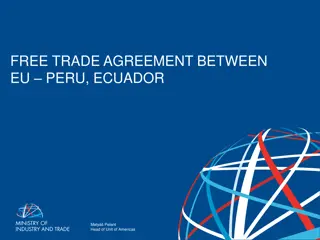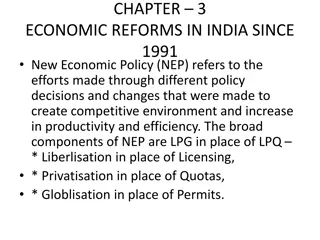Overview of Industrial Policy in India
Industrial policy in India encompasses a set of standards and measures established by the government to regulate and enhance the growth of the manufacturing sector, thereby contributing to economic development. It aims to maintain productivity, create employment opportunities, optimize human resourc
0 views • 7 slides
Empowering Farmers Through Market Surveys
The market survey methodology outlined in the content focuses on empowering farmers by increasing their understanding of market dynamics, building relationships with market players, and enhancing decision-making skills. It involves structured steps like sensitization workshops, crop selection, and i
1 views • 23 slides
Understanding Market Sharing Cartels in Oligopolistic Markets
Perfect collusion in oligopolistic markets often involves market-sharing cartels, where member firms agree to share the market while allowing some degree of freedom in their decisions. This can be done through non-price competition or quota agreements. Non-price competition cartels involve setting a
8 views • 8 slides
Understanding Capital Market and Its Significance
Capital market refers to the market for long-term finance where financial assets like Shares, Debentures, and Bonds are traded. It plays a vital role in mobilizing funds for companies and governments, facilitating capital formation, and promoting economic growth. The classification includes Industri
0 views • 11 slides
Impact of New Economic Policy 1991 on Indian Economy
India implemented the New Economic Policy in 1991 to address the failures in fiscal policy and balance of payment crisis. This policy focused on delicensing, privatization, liberalization, and globalization of the economy. The changes led to increased competition, demanding customers, technological
0 views • 9 slides
Understanding ISO 9000 and 14000 Standards for Quality Management
ISO 9000 and 14000 are international standards developed by the International Organization for Standardization to establish and maintain effective quality management systems. They provide guidelines for quality audits, monitoring, and continuous improvement for businesses in various industries. Comp
0 views • 21 slides
Chile's Financial Services Liberalization Overview
This content provides an in-depth look at Chile's main reservations under the OECD Codes of Liberalization, including its context of accession to OECD Free Trade Agreements and commitments to liberalization in services, investments, and financial services. It covers aspects such as cross-border trad
5 views • 20 slides
Melanesian Spearhead Group (MSG) Trade Agreement Overview
This overview provides information on the Melanesian Spearhead Group Trade Agreement (MSGTA), its background, objectives, parties involved, preferential treatment accorded, rules of origin, and more. The agreement aims to enhance intra-regional trade, promote fairness and competition, and contribute
0 views • 17 slides
Comparison of Abortion Laws in Malawi and Zambia
Dr. Ernestina Coast and Dr. Emily Freeman from the London School of Economics conducted research on the critical conjunctions of abortion laws and policies in Malawi and Zambia. The current legal positions in both countries differ, with Malawi allowing a broader range of legal grounds for abortion c
0 views • 30 slides
Overview of Ghana's Petroleum Downstream Industry
The Ghana Petroleum Downstream Industry plays a vital role in the transportation, processing, distribution, and marketing of refined petroleum products. The industry has seen key policy objectives focusing on deregulation and liberalization to promote competition and efficiency. Historical milestone
3 views • 23 slides
Structural Transition and International Economic Institutions in Post-Independence India
Post-independence India initially focused on state-directed economic development, leading to a sizable public sector. However, in 1991, the country shifted towards a structural adjustment program, embracing liberal imports, market deregulation, privatization, and financial liberalization. This trans
0 views • 10 slides
Recent Developments in Commodity Market Ecosystem and Global Competitiveness of Nigeria
The recent report from the last CMC meeting highlights the significance of developing the commodities market and the ecosystem's composition. It identifies multiple benefits of a thriving commodities market and discusses the evolution of commodity trading markets globally, continentally, and in Nige
0 views • 6 slides
Malaysia's Comprehensive Development Planning Strategies
Malaysia's experience in compiling statistics for development planning is highlighted through the high-level seminar and workshop on the ACSS Strategic Plan 2016-2020. The country's development plans include the 11th Malaysia Plan, Government Transformation Programmes, New Economic Model, and Econom
0 views • 11 slides
Ownership and Control Regulations in ASEAN Air Transport Industry
The content discusses ownership and control restrictions in the air transport industry across ASEAN countries, outlining foreign ownership limits and regulations. It highlights the need for liberalization to align with the ASEAN Comprehensive Investment Agreement (ACIA). Various ownership models are
0 views • 4 slides
Understanding Market Research for Business Success
Market research is crucial for businesses to gather information about their target market, customer needs, competition, and market trends. Primary and secondary research methods, market share analysis, demand assessment, and calculating market size are key aspects discussed in this content. Various
1 views • 5 slides
Chile's Regulatory Framework for Capital Movements and Essential Security Measures
Chile's position under the OECD Code of Liberalization of Capital Movements is described along with its commitments in free trade agreements. The regulatory framework for capital movements in Chile allows for liberal participation of foreigners, with certain restrictions in sectors like air transpor
0 views • 21 slides
Dutch Health Care Reform: A Reflective Overview of System Evolution
The Dutch health care system underwent significant reforms between 1980 and 2020, moving from cost containment to market liberalization, patient empowerment, and integration of care. The journey involved addressing rising costs, redesigning systems, market liberalization, and emphasizing chronic car
0 views • 13 slides
Exploring Nazi Folk Community and Social Dynamics in Germany
In this detailed exploration, you will delve into the intricate social structures of the Nazi folk community in Germany. From the expulsion of individuals to the liberalization of sexuality, the role of women, youth organizations, education system coordination, and foreign relations, you will learn
0 views • 11 slides
Free Trade Agreements Between EU, Peru, and Ecuador
The Free Trade Agreement (FTA) between the EU, Peru, and Ecuador covers market access for agricultural and industrial goods, services, establishment, and government procurement. Tariffs and technical barriers to trade are gradually eliminated, with provisions for intellectual property protection. Pe
0 views • 8 slides
Automotive Tic
The automotive sector is facing several challenges, including stringent environmental and safety regulations. Globalization and liberalization have highlighted safety as a prime concern among automotive consumers. Increasing risks on the road have co
0 views • 4 slides
Strategic Management in Modern Business Environment
In the era of liberalization, privatization, and globalization, companies must evolve and adapt to succeed. Strategic management plays a crucial role in helping organizations formulate effective strategies to achieve their objectives. This involves making informed decisions, optimizing profits, and
0 views • 7 slides
Challenges Faced by Mexico Under CLCM and Establishment of Financial Institutions
Mexico faced challenges related to national security concerns and the establishment of branches of financial institutions under the Codes of Liberalisation of Capital Movements (CLCM). The country's entry into the OECD in 1994 marked a significant period of liberalization and reforms, including exte
0 views • 13 slides
Linkages Between Agriculture and Rural Nonfarm Economy for Rural Transformation in Africa
Agriculture plays a key role in driving rural economic growth in developing regions, with strong linkages to the rural nonfarm economy (RNFE). As agriculture prospers, so does the RNFE. However, over time, the dependence on agriculture decreases as countries urbanize and diversify. Recent trends in
0 views • 10 slides
Impact of ZLECAf in North Africa: Empirical Evaluation
The Economist, Aziz Jaid, from the CEA Bureau for North Africa conducted an empirical evaluation on the impact of the ZLECAf in North Africa, focusing on goods. The context includes coverage of seven countries, the rationale behind the ZLECAf agreement, and details on the liberalization scenarios an
0 views • 13 slides
Labor Market Reforms and Unemployment: A Detailed Analysis
Labor market reforms and their impact on unemployment rates are examined through a Difference-in-Differences analysis in this study led by Armingeon and Baccaro in June 2013. The research questions whether liberalizing reforms actually reduce unemployment and increase employment levels. The findings
0 views • 13 slides
Livestock Economics and Marketing: Market Information and Institutional Approach
Market information plays a crucial role in livestock economics and marketing by providing essential knowledge on prices, quantities, and stocks, aiding decision-making for farmers and market intermediaries. It encompasses market news and market intelligence. The collection of market information is d
0 views • 11 slides
Comparison of Economic Reform Sequencing in China
Andrew K. Rose from NUS Business School compares China's economic reform sequencing with the Washington Consensus. The optimal reform sequencing includes stabilization before reform, real before financial reform, and domestic before international reform. China's approach aligns oddly with the Washin
0 views • 14 slides
Overview of Economic Reforms in India Since 1991
The New Economic Policy (NEP) in India since 1991 focused on liberalization, privatization, and globalization to enhance competitiveness, productivity, and efficiency. The policy aimed to address challenges like unsatisfactory public sector performance, high inflation rates, debt burdens, and balanc
0 views • 43 slides
Global Trade Dynamics: Mega-Regionals and Strategic Implications
Examining the impact of mega-regionals like TTIP and TPP on global trade dynamics, focusing on regulatory agendas, outcomes scenarios, and strategic challenges for developing countries. The growth of regionalism in contrast to the WTO's stasis, the significance of systemically important trade agreem
0 views • 21 slides
Understanding BCG Matrix: Market Growth and Relative Market Share
BCG Matrix, developed by Bruce Henderson of the Boston Consulting Group, categorizes business units into Question Marks, Stars, Cash Cows, and Dogs based on market growth and relative market share. Market share and market growth are crucial factors in determining a company's position in the market.
0 views • 31 slides
Difference Between Capital Market and Money Market: A Comprehensive Overview
The capital market and money market serve different purposes in the financial world. While the capital market provides funds for long-term investments in securities like stocks and debentures, the money market deals with short-term borrowing and lending of funds. The capital market acts as a middlem
0 views • 4 slides
Theories of International Integration: From Neoliberalism to Structuralism
The concept of international integration has evolved over time, with classic theories like federalism and functionalism giving way to newer ideas like neoliberalism and structuralism. Neoliberalism emphasizes economic liberalization for improved competitiveness and living standards, while structural
0 views • 56 slides
Understanding EU-Japan EPA for Textile & Clothing Products
This presentation simplifies the EU-Japan EPA, detailing market access concessions and examples of EU textile products exported to Japan. It emphasizes the significant liberalization for all textile and clothing products under the agreement, including details on duty-free categories and gradual tari
0 views • 14 slides
ORGANIZATION OF CASHEW SECTOR POLICIES IN AFRICA
The article discusses the organizational policies in the cashew sector in Africa, focusing on the free movement of goods and people in the ECOWAS zone. It highlights the obstacles to trade such as roadblocks and illegal payments along various corridors. It concludes with the challenges faced in impl
0 views • 8 slides
Overview of Regional Training Workshop on International Merchandise Trade Statistics and MSG Trade Agreement
The Regional Training Workshop focuses on International Merchandise Trade Statistics Compilation, Analysis, and Dissemination, shedding light on the Vision of MSG 2038 Prosperity for All Plan, MSG Trade Agreement, and key recommendations. The workshop delves into the background of MSGTA, its evoluti
0 views • 16 slides
Trade and Poverty Reduction in Africa: A Quantitative Analysis
The study explores the relationship between trade and poverty reduction in Africa from 1990 to 2014 using a panel Vector Autoregressive framework. Various channels of influence, such as price/distribution and wages/employment, are examined for their impact on poverty alleviation. Trade liberalizatio
0 views • 19 slides
Understanding Economic and Social Globalization
This final session explores economic and social globalization, covering topics like the impact on trade and investment, globalization dynamics, and civil society in a globalized world. Key readings and insights on economic globalization, international trade, and global investment are presented, high
0 views • 25 slides
automotive tic market (2)
The automotive sector is facing several challenges, including stringent environmental and safety regulations. Globalization and liberalization have highlighted safety as a prime concern among automotive consumers. Increasing risks on the road have co
1 views • 4 slides
Lessons on Capital Account Liberalization in Latin America: A Historical Overview
Explore the evolution of capital account liberalization in Latin America from 1950 to 2013, highlighting key events such as the Latin American debt crisis, post-crisis capital flows, and regulatory phases. The comparison with emerging market economies sheds light on the region's capital account rest
0 views • 11 slides
Understanding International Legal Frameworks in Phytosanitary Regulations
Exploring the international legal framework surrounding phytosanitary regulations is essential for understanding obligations placed on countries to protect human, animal, and plant health. Key aspects include international treaties, soft law instruments, the WTO SPS Agreement, and the role of the Wo
0 views • 20 slides







































